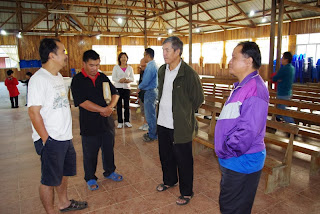Ba'kelalan is a group of nine villages in the Bario Highlands of Sarawak, Malaysia about 3000 feet above sea level and 4 km from the border with Indonesian Kalimantan. The villagers belong to the Lun Bawang tribe. The villages are Buduk Nur, Long Langai, Long Lemumut, Long Ritan, Long Rusu, Pa Tawing, Buduk Bui, Buduk Aru and Long Rangat.
The name Ba’Kelalan is derived from the Kelalan River and Ba’ which means wet lands in the Lun Bawang language. Its population is about 1500 but as many as 8000 call it home. In the cool mountain climate, temperate fruits such as apples, mandarin oranges and vanilla are grown. The area also produces rice, and mountain salt is obtained from the nearby hills. The people in Ba'Kelalan are Christian, members of the Sidang Injil Borneo, and rice production has doubled since the prohibition of alcohol. (gulp)
 We departed KK early to beat the morning traffic jam. Also to reach Ba Kelalan with some daylight to spare. I woke up at 4.30 am, Pst Jubilie came to fetch me at 5.00 am, and after some delay, our rented van drove out of KK by 6.00 am. The skies were just brightening.
We departed KK early to beat the morning traffic jam. Also to reach Ba Kelalan with some daylight to spare. I woke up at 4.30 am, Pst Jubilie came to fetch me at 5.00 am, and after some delay, our rented van drove out of KK by 6.00 am. The skies were just brightening. Everybody was excited for the trip. Haze was pretty bad along the way. It has not rained in KK for months. Of course, political talk was part of the topic. We reached some agreement on who to vote out next election. Hehehe...
Everybody was excited for the trip. Haze was pretty bad along the way. It has not rained in KK for months. Of course, political talk was part of the topic. We reached some agreement on who to vote out next election. Hehehe... At the Sindumin border checkpoint. We had to get down the van to fill up a form, or have our passports stamped. The counters for exiting Sabah and entering Sarawak were located side by side, making the process quite effortless.
At the Sindumin border checkpoint. We had to get down the van to fill up a form, or have our passports stamped. The counters for exiting Sabah and entering Sarawak were located side by side, making the process quite effortless. Arrive in Lawas by 9.00am, with lots of time to spare. Here's our first taste of Sarawakian specialty... the Kon Lo Mee. Food wasn't too great, but price was cheap, RM 2.80 only! Tell me again, why are things in KK are so expensive?
Arrive in Lawas by 9.00am, with lots of time to spare. Here's our first taste of Sarawakian specialty... the Kon Lo Mee. Food wasn't too great, but price was cheap, RM 2.80 only! Tell me again, why are things in KK are so expensive? After breakfast, we had to spend some time waiting for the 4WD driver to get our stuffs packed onto the truck (wondered what took him so long). Getting away from the scorching heat, the ice creams were great relief.
After breakfast, we had to spend some time waiting for the 4WD driver to get our stuffs packed onto the truck (wondered what took him so long). Getting away from the scorching heat, the ice creams were great relief.

















































